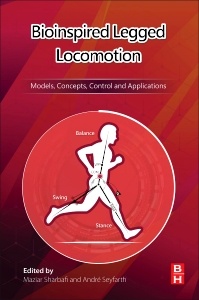Bioinspired Legged Locomotion Models, Concepts, Control and Applications
Coordonnateurs : Sharbafi Maziar Ahmad, Seyfarth André

Bioinspired Legged Locomotion: Models, Concepts, Control and Applications explores the universe of legged robots, bringing in perspectives from engineering, biology, motion science, and medicine to provide a comprehensive overview of the field. With comprehensive coverage, each chapter brings outlines, and an abstract, introduction, new developments, and a summary.
Beginning with bio-inspired locomotion concepts, the book's editors present a thorough review of current literature that is followed by a more detailed view of bouncing, swinging, and balancing, the three fundamental sub functions of locomotion. This part is closed with a presentation of conceptual models for locomotion.
Next, the book explores bio-inspired body design, discussing the concepts of motion control, stability, efficiency, and robustness. The morphology of legged robots follows this discussion, including biped and quadruped designs.
Finally, a section on high-level control and applications discusses neuromuscular models, closing the book with examples of applications and discussions of performance, efficiency, and robustness. At the end, the editors share their perspective on the future directions of each area, presenting state-of-the-art knowledge on the subject using a structured and consistent approach that will help researchers in both academia and industry formulate a better understanding of bioinspired legged robotic locomotion and quickly apply the concepts in research or products.
1. Introduction
Part I : Concepts 2. Fundamental sub-functions of locomotion 3. Conceptual models for locomotion
Part II: Control 4. Control of motion and compliance 5. Torque control in legged locomotion 6. Neuromuscular control in locomotion
Part III: Implementation 7. Legged robots with bio-inspired morphology 8. Actuation in legged locomotion 9. Conclusions and outlook (How far are we from Nature?)
Scholars in motion science, (control/mechanical) engineering, robotics, medicine, biology, Companies in robotics and biorobotics, biomedical engineering
André Seyfarth is full professor for Sports Biomechanics at the Department of Human Sciences of TU Darmstadt and head of the Lauflabor Locomotion Laboratory. After his studies in physics and his PhD in the field of biomechanics he went as a DFG “Emmy Noether fellow to the MIT LegLab (Prof. Herr, USA) and the ParaLab at the university hospital Balgrist in Zurich (Prof. Dietz, Switzerland). His research topics include sport science, human and animal biomechanics and legged robots. Prof. Seyfarth was the organizer of the Dynamic Walking 2011 conference („Principles and concepts of legged locomotion“) and the AMAM 2013 conference (“Adaptive Motions in Animals and Machines).
- Presents state-of-the-art control approaches with biological relevance
- Provides a thorough understanding of the principles of organization of biological locomotion
- Teaches the organization of complex systems based on low-dimensional motion concepts/control
- Acts as a guideline reference for future robots/assistive devices with legged architecture
- Includes a selective bibliography on the most relevant published articles
Date de parution : 11-2017
Ouvrage de 698 p.
15x22.8 cm



